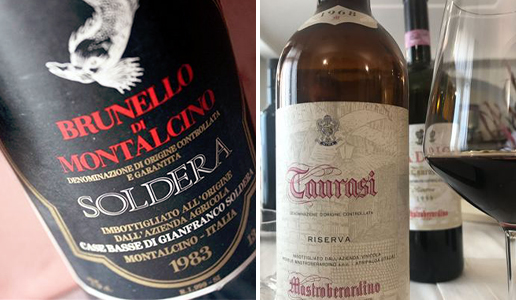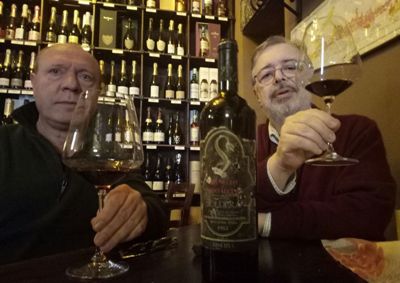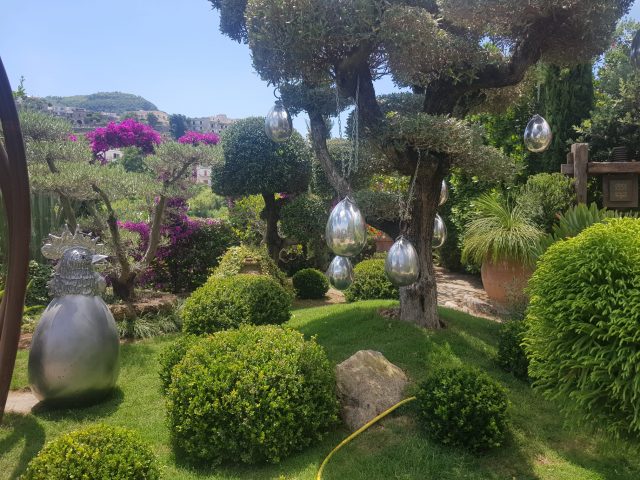Two historic wines at 100/100

On two different and very recent occasions, I was able to taste a Taurasi Riserva 1968 Mastroberardino and a Brunello di Montalcino Riserva 1983 Case Basse, two immense wines that made Italian winemaking history.
Because I always seem to find myself caught up writing editorials on a variety of different topics, I often forget to write about my own personal encounters with wines that are well-worth the attention. I recently had the opportunity, on two successive days, to taste two wines that made Italian winemaking history and that have become increasingly hard to find because so few bottles are left.
 On Friday, March 30th, I went with Antonello Amodio, who often writes for us, to visit Piero Mastroberardino at his winery in Atripalda, near Avellino. We went to learn more about two new wines were about to make their debut, a Fiano di Avellino and a Taurasi, as part of their new Stilema line. He assured me these wines would revolutionize winemaking in Irpinia and this because, above all in the case of the Taurasi, his idea was to bring back an ancient winemaking approach his father had developed. Along with the wine in question, which was a 2015 and thus very young, he opened a Taurasi Riserva 1968, which was perhaps the greatest red wine produced in southern Italy in its time and one of the greatest Italian red wines of all time.
On Friday, March 30th, I went with Antonello Amodio, who often writes for us, to visit Piero Mastroberardino at his winery in Atripalda, near Avellino. We went to learn more about two new wines were about to make their debut, a Fiano di Avellino and a Taurasi, as part of their new Stilema line. He assured me these wines would revolutionize winemaking in Irpinia and this because, above all in the case of the Taurasi, his idea was to bring back an ancient winemaking approach his father had developed. Along with the wine in question, which was a 2015 and thus very young, he opened a Taurasi Riserva 1968, which was perhaps the greatest red wine produced in southern Italy in its time and one of the greatest Italian red wines of all time.
“Imagine, maceration on the skins lasted on a dozen or so days, no more”, Piero told me to underscore how the practice of keeping the wine in contact with the skins for a long time was much less “traditional” than might appear. The Taurasi in question is about to turn 50, which for a wine is infinite, but it seemed as if it had been made yesterday.
The color is still very lively, an intense ruby-garnet, without any orange reflections, which are a clear indication of age. The aromas, aside from a balsamic note, still included scents of the original fruit, black cherry also in jam form, which still had amazing precision and clearness. There were no spice or vanilla sensations, at the time they used only large barrels for maturing the wine. The mouthfeel was upheld by a distinct acidic backbone, the fundamental reason for why it has held up so extraordinarily well, which “duetted” with what remained of the tannins and with an agile and very elegant structure that gave it an almost “Burgundy-esque” drinkability. The way it has stood the test of time is incredible and I don’t think anyone could guess the real age of this wine that seems so fresh and young and still has such a long life ahead of it”.
The second tasting took place the next day at the Goccetto, the Rome wine bar that if it is not my second home it is certainly my second office. It was Saturday, March 31, and proprietor Sergio Ceccarelli wanted to celebrate his 60th birthday by opening a bottle of Brunello di Montalcino Riserva 1983 Case Basse he still had in his cellar. Back then Gianfranco Soldera’s last name was still written on the label in small letters. Another immense wine, one which marked an era and lifted that estate to be among the world winemaking elite.
 A bold, ruby-garnet color and aromas with an incredible intensity without any signs of yielding. There were notes of kirsch, black cherry preserved in alcohol, a little cacao, currant and some hints of licorice. All this created a bouquet of rare complexity and amazing youth without even the slightest hint of excessive volatile notes. The mouthfeel was explosive with tannins that were still robustly ruling the center of the palate and a core acidity that restored agility and drinkability to a flavor of formidable personality. A very great wine, territorial and authentic. Perhaps the greatest Italian red wine of its era and perhaps the best Soldera ever made, at least for me.
A bold, ruby-garnet color and aromas with an incredible intensity without any signs of yielding. There were notes of kirsch, black cherry preserved in alcohol, a little cacao, currant and some hints of licorice. All this created a bouquet of rare complexity and amazing youth without even the slightest hint of excessive volatile notes. The mouthfeel was explosive with tannins that were still robustly ruling the center of the palate and a core acidity that restored agility and drinkability to a flavor of formidable personality. A very great wine, territorial and authentic. Perhaps the greatest Italian red wine of its era and perhaps the best Soldera ever made, at least for me.
Wines of times past? For sure, climate change then was still an hypothesis and not a reality. Winemaking practices were in evolution, there was not only one acritical method but neither were there any leaps forward by the “modernists”. The profound significance of those wines, however, was their “high” craftsmanship, proposed by people who were not simple winemakers but the “trailblazers” of winemaking at the time, producers who interpreted traditional methods with personal and articulate experience and sensibility. Qualities that are still valid and appreciated today.

 Italiano
Italiano








